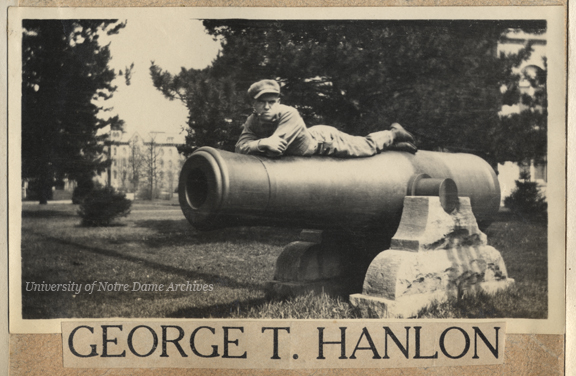
On May 22, 1896, the United States Congress approved the Disposition of Condemned Cannon, Etc., which provided the Secretaries of War and of the Navy the authority “to loan, or give to soldiers’ monumental associations, posts of the Grand Army of the Republic, and municipal corporations, condemned ordnance, guns, and cannon balls which may not be needed in the service of either of said Departments” (Annual Reports of the War Department, 1903). In December 1899, Notre Dame GAR Post 569 filed a petition with the Secretary of War to acquire two cannons for campus.

With the help of Indiana Representative Abraham Brick, Notre Dame requested a ten-inch Columbiad cannon from Fort Winthrop in Massachusetts and a ten-inch seacoast mortar from Fort Morgan in Alabama. After about six months of back and forth, the Fort Morgan mortar became unavailable. It is unclear if the deal fell through because getting the mortar to Notre Dame would be too expensive or if they simply took too long figuring out the logistics. Consequently, the request was changed to an eight-inch seacoast howitzer from Fort McHenry in Maryland.

General William Olmstead of Notre Dame GAR Post 569 inquired about the history of the gun at Fort Winthrop. Ordnance Sergeant Joseph R. Neaves responded that he didn’t think it had much of a history – it came to Fort Winthrop in the late 1850s or early 1860s and that it probably was never fired since it wasn’t mounted (UPEL 87/05).
The cannons arrived to Notre Dame sometime before September 22, 1900, when they are first mentioned in Scholastic. The article recounts how football manager John Eggeman went looking for his billy goat during a storm, and “[a]fter a long search, John discovered the goat trying to eat one of the cannons down near the post-office. Of course this was a bluff on the part of the goat” [Scholastic, 09/22/1900, page 59].

The cannons were located next to the flag pole, which then was just west of Hurley Hall. While they were a prominent part of the landscape, they didn’t garner much attention in the student publications. Due to their location, they stood as sentinels during flag-raising ceremonies. In later years, it became tradition for the graduating head cheerleader to lead one last college yell from atop one of the cannons during the flag-raising ceremony at Commencement.

In 1942, Notre Dame donated the cannons to a scrap drive to support the war effort of World War II, thus returning them back to the United States military and putting them back to work for a new war.

Sources:
Scholastic
UPEL 79/03
UPEL 87/04-12
GNDL 8/01
GNDS 9/15
GDIS 46/03
Annual Reports of the War Department, 1903 (https://books.google.com/books?id=NvAkAAAAYAAJ&printsec=frontcover&source=gbs_ge_summary_r&cad=0#v=onepage&q&f=false)
